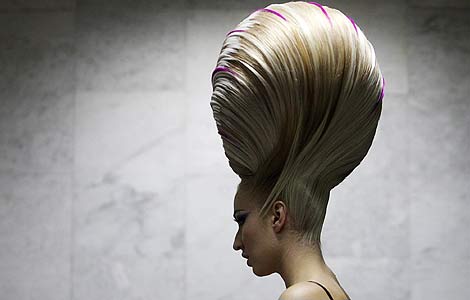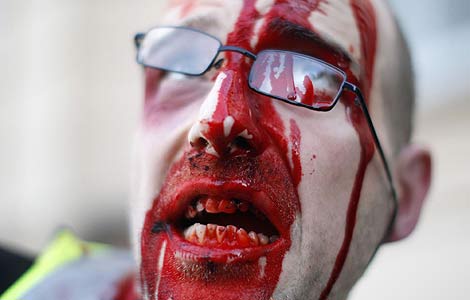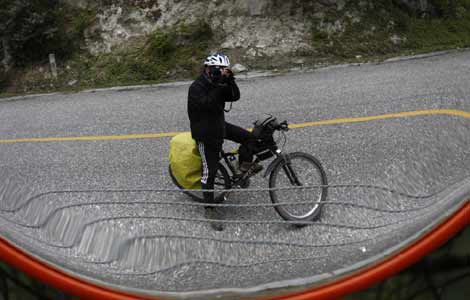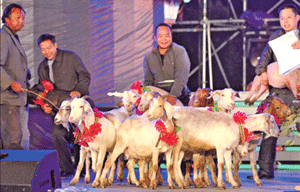A look behind the making of 'Terra Nova' dinosaurs
Updated: 2011-10-01 11:54
(Agencies)
|
|||||||||
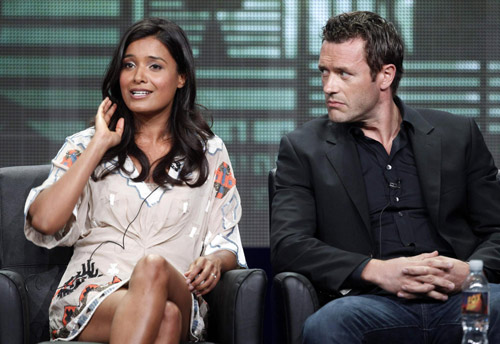 |
|
British actress Shelley Conn and Irish actor Jason O'Mara, stars of the new series "Terra Nova" speak during a panel session at the FOX Summer TCA Press Tour in Beverly Hills , California August 5, 2011. [Photo/Agencies] |
Everybody knows what dinosaurs look and sound like. After all, who hasn't seen the "Jurassic Park" movies.
So what if your boss is Steven Spielberg -- the guy who created that movie and is chiefly responsible for those dinosaurs? And he says that for his new TV show, "Terra Nova," make me dinosaurs but don't make them look or sound like "Jurassic Park" dinosaurs?
"You can see the dilemma," deadpanned Michael Graham, the supervising sound designer for Spielberg's new Fox series, "Terra Nova," which debuted on TV earlier this week.
"Everybody who's seen that movie knows -- that's what they sound like! That is the vocabulary of dinosaurs," Graham said.
In "Terra Nova," humans are sent back in time to escape the overcrowded and polluted future of 2149. And they go WAY back to prehistoric times when massive animals with scaly skin, sharp teeth and names that end with "-aurus" ruled Earth.
The show drew a solid audience of 9.7 million viewers on its debut night last Monday, and reviews were mostly positive. The New York Times said the story was "lavishly produced by television standards, at a level of visual and technical sophistication" befitting its two years from script to screen.
The dinos of "Terra Nova" don't look or sound like their theatrical predecessors, and for good reason. Jack Horner, the show's paleontology expert who worked with Spielberg on "Jurassic Park" made sure of it.
"Jack set our show in the Cretaceous Period, 85 million years ago," explains visual effects supervisor Kevin Blank. "That's a period where the fossil record is the least defined. They only know about 10 percent of what existed at that time."
So Blank and his team were able to give audiences dinos that audiences may have heard of, like the menacing Carnotaurus and the gentle, long-necked Brachiosaurus, as well as some we probably haven't.
NEW DINOS, LOUD ROARS
The Slasher Tails in the premiere episode, for instance, never existed but they might as well have, says executive producer Brannon Braga. "We needed a big, climactic dinosaur, so I thought, 'What's one that didn't exist but could have existed?' Then we just go for the Jack Horner seal of approval, in terms of appearance and behavior. We do that for any animal we create."
Creating the behavior of dinos is "the fun part" for the writers. "You can't just throw a dinosaur up on screen, especially if it's one you're making up," says Braga. "They have to have specific behaviors. Maybe they travel in packs, like the Slashers do. And maybe one scouts the area, and when it finds its prey, calls for others. First there are two Slashers ... and then there are a dozen others."
But it is most important that even the made-up dinosaurs look real to audiences. "If a six-year-old who loves and studies dinosaurs spots something that doesn't look right, they'll cry 'Fake!' And Jack says he gets those letters all the time," said Blank.
And that all leaves one critical question. How do the special effects wizards create the sound of a dinosaur?
They're a mixture of sounds, it turns out, but one element is common, they all roar.
"You can use a bear, a lion, a cougar, and we manipulate them so that they fit the size of the creature," said Graham.
For the Carnotaurus, Graham and his team sought to come up with a new terrifying sound. "That was a challenge. The producers definitely didn't want to hear the T. Rex sound. So we had to create a new, intimidating dinosaur sound."
Rick Steele, Graham's chief dino sound designer, injected the sound of a bird -- a condor, in this case -- into the Carno. "You hear it at the tail end when they attack," he explains.
"The hardest part," Steele said, "is to try and create a personality," making the dino vocalizations match the expressions the animators put on their faces.
"Remember, these aren't monsters - they're characters."


